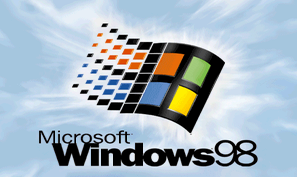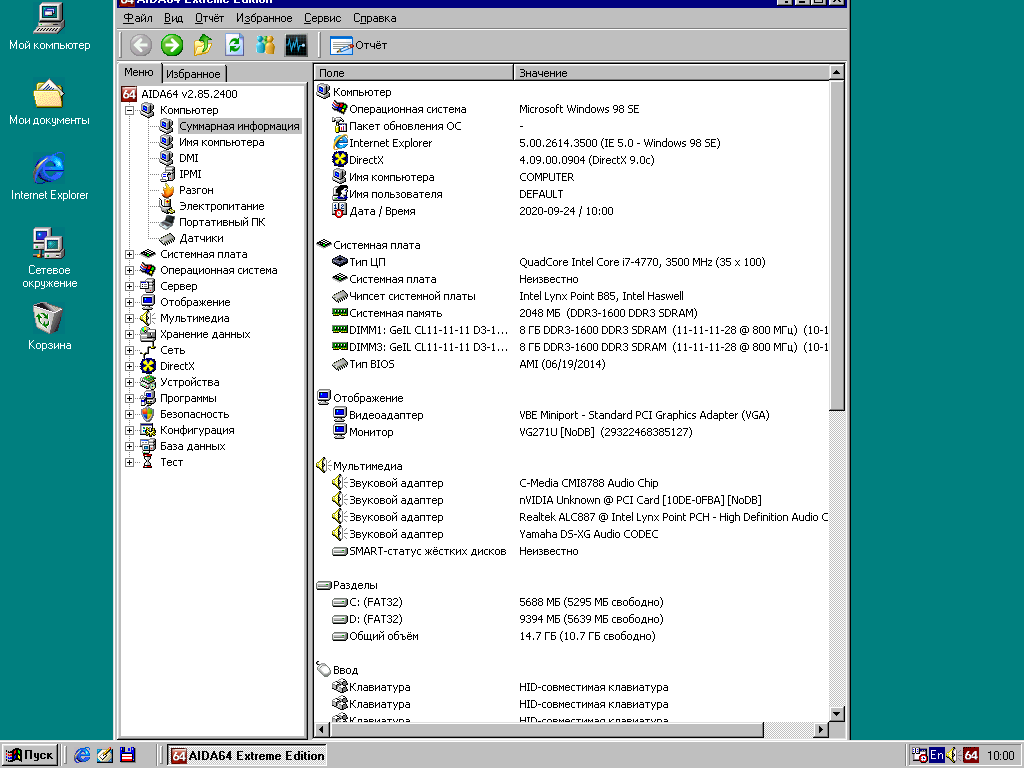
I decided to share my recipe for how I installed Windows 98SE on a relatively modern PC. There are many messages on the Internet forums that Windows 98SE cannot be installed on modern PCs, does not run on PCI-e video cards, etc., so the article may be useful for those who want to start old sound cards like Aureal Vortex 2, to feel nostalgic or just for the sake of sports interest.
I will immediately announce the configuration of my PC, on which I achieved a positive result: a Core i7-4770 processor, a motherboard on a B85 chipset with a PCI slot via a PCI bridge, 16GB of RAM, a GeForce 960 video card, a 16GB SSD - the cheapest one I found on AliExpress. I will not give detailed instructions for installing Windows 98SE - only key points.
On my PC, there are 2 other SSDs for Windows XP and 7k, so in the BIOS I have SATA configured in AHCI (not IDE) mode. Surprisingly, Windows 98SE was installed in AHCI mode without any problems, as if on an old IDE HDD, but Windows XP / 2003 will never install in AHCI mode without a special driver. But on the other hand, Windows 98SE won't just install if the PC has more than 512 MB of RAM installed, so after the first stage of installation, after the first reboot, you need to boot in command mode (I have Norton Commander running in autoexec.bat) and replace the patched HIMEM memory manager .SYS, VCACHE.VXD and VMM.VXD. The patch is called "Patch_win98se_for_full_memory_access.Multi (rus)"... I always have a blue screen during hardware diagnostics, but after a reboot, the installation continues to the end without any problems.
This is how the screen looks after installation:

resolution 640 * 480, 16 colors, some artifacts on my GeForce 960 and the most interesting thing - there are no PCI devices, chipset components, etc. in Device Manager. For a long time I thought that Windows 98SE did not understand the PCI-e bus, did not see a modern chipset that did not support the PCI bus, I thought that I needed to install a PCI-e patch, which was not available for Windows 98. But just recently I accidentally found a solution ... After installation, I first installed the kernel patch KernelEx-4.5.2, and then went to the Add Device Manager and decided to try adding a PCI bus. Immediately after that, all sorts of PCI-to-PCI Bridges began to be detected, Asus Xonar DGX was found, which was sticking in the PCI slot and other devices:

For the sake of experiment, I reinstalled Windows 98 again and added a PCI bus without KernelEx - it did not work, PCI- devices were not initialized even after the subsequent addition of KernelEx. First KernelEx, then PCI bus.
Next, you need to configure the video card - you don't have to buy an old one for this. Installing the VBEMP 9x Project driver- universal (for any video card) VESA / VBE video driver for Windows 9x architecture, produces 32-bit color on the Desktop at a resolution up to 2560 * 1600. In general, nVidia has officially released a driver for Windows 98 for the 6000 series (81.98), but there is an unofficial driver 82.69 , which can be installed on the Russian version of Windows 98SE only manually (not through setup). In inf which are written up to GeForce 9800. For the sake of experiment I bought a GeForce 7300 on the PCI-e slot - everything worked fine despite many reports that Windows 98 does not work with video cards on the PCI-e slot, the games also started. Unfortunately, gpu-z does not start on Windows 98, so I show through AIDA64:

To make USB sticks work, you need to install the nusb driver, it is better to take the latest version 3.6. A bunch of drivers for old devices ftp://ftp.dyu.edu.tw/pub/Hardware/stuff/multimedia/
Well, that's all for the basic setup - nothing more complicated. It is more convenient to run Windows 98 from a separate SSD / HDD on a working PC than to assemble a separate old-retro system unit. I needed Windows 98 to test my Yamaha 744 - this is the only sound card on a PCI slot with a high-quality OPL3 FM synthesizer. If someone needs a modern PC with an ISA slot for special boards, then you can build a PC on socket 1150 MBC-6605 or on socket 1151 MS-98L9 V2.0 for Intel 7th / 6th generation processors.
The installation process can be simplified and accelerated if you prepare an MSBATCH.INF response file, you can read more about this here - http://sergeytroshin.ru/articles/windows-98-unattended/

